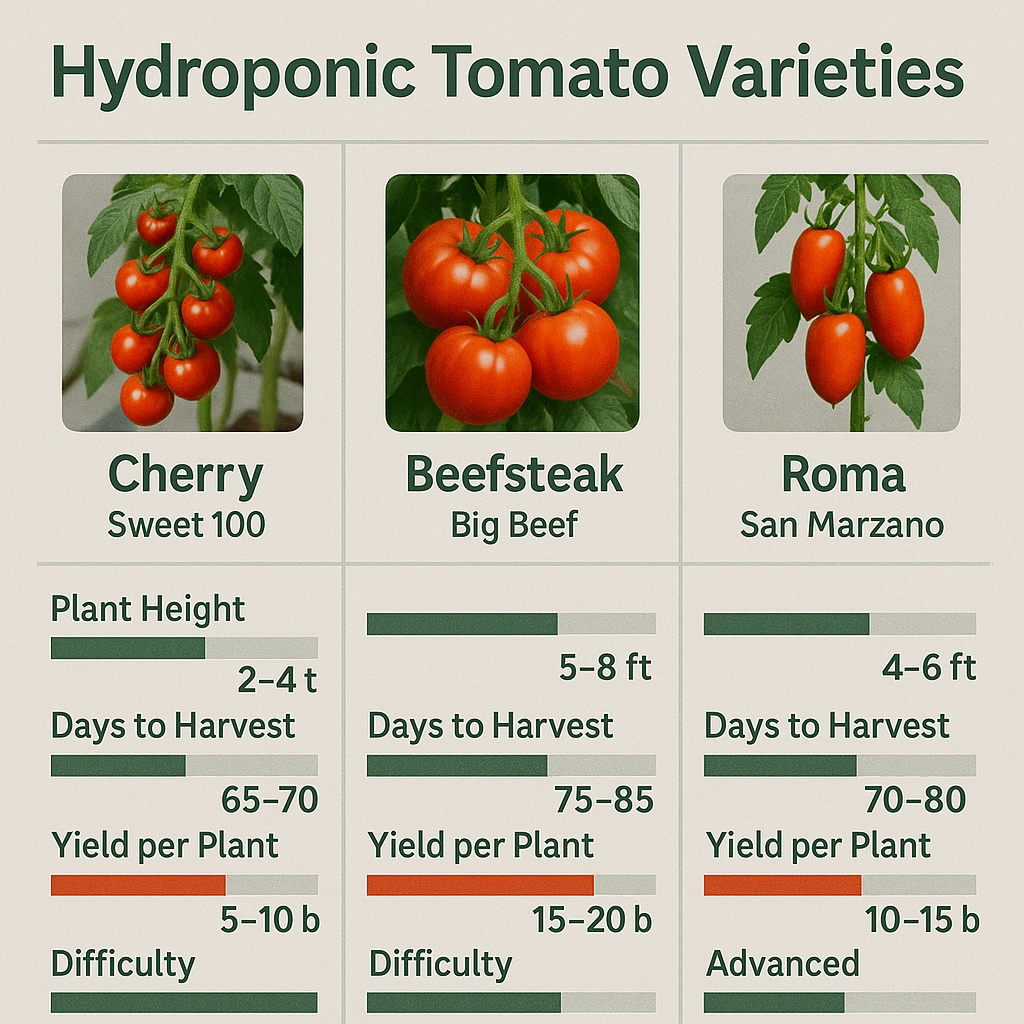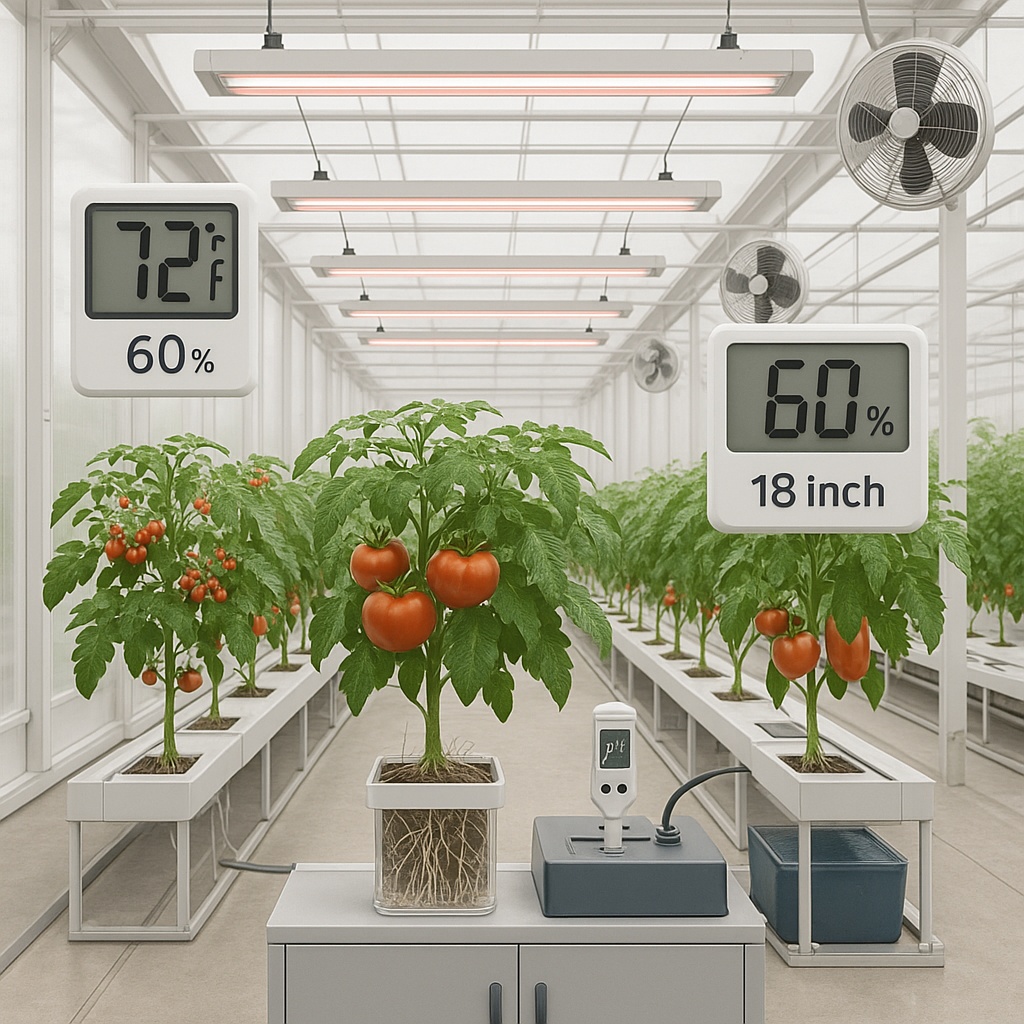Growing hydroponic tomatoes opens up a world of possibilities for home gardeners and commercial growers alike. Unlike traditional soil gardening, hydroponic tomatoes cultivation offers precise control over nutrients, faster growth rates, and year-round production potential. This comprehensive guide will walk you through the essential first steps of starting your hydroponic tomatoes journey, focusing on variety selection and proper planning.
Why Choose Hydroponic Tomatoes?
Hydroponic tomatoes cultivation has gained tremendous popularity due to its numerous advantages over traditional soil growing. Research conducted by the University of Arizona demonstrates that hydroponic tomatoes can yield 3-10 times more fruit per square foot compared to soil-grown plants [1]. The controlled environment eliminates soil-borne diseases, reduces pest problems, and allows for optimal nutrient delivery directly to the root system.
The faster growth cycle is particularly appealing to both hobbyists and commercial growers. While soil-grown tomatoes typically take 75-85 days from transplant to first harvest, hydroponic tomatoes can reduce this time to 65-75 days under optimal conditions. This acceleration occurs because roots don’t need to search for nutrients and water – everything is readily available in the perfect concentration.

Choosing the Right Hydroponic Tomatoes Varieties
Selecting appropriate hydroponic tomatoes varieties is crucial for success. Not all hydroponic tomatoes perform equally well in soilless systems, and your choice will significantly impact your harvest quality and quantity. For more detailed information on hydroponic equipment basics, check our comprehensive equipment guide.
Determinate vs. Indeterminate Varieties
Indeterminate varieties are the preferred choice for most hydroponic tomatoes systems. These “vining” tomatoes continue growing and producing fruit throughout the growing season until frost or disease stops them. Popular indeterminate hydroponic tomatoes varieties include:
- Beefsteak types: Big Beef, Cherokee Purple, Brandywine
- Cherry varieties: Sweet 100, Sun Gold, Black Cherry
- Slicing tomatoes: Early Girl, Celebrity, Better Boy
Determinate varieties produce all their fruit within a concentrated period, typically 4-6 weeks. While they can work in hydroponic tomatoes systems, they’re less efficient for long-term production. However, they might be suitable if you want a large harvest for canning or sauce-making.
Best Hydroponic Tomatoes Varieties
Based on extensive hydroponic tomatoes growing trials, these varieties consistently perform well in soilless systems:
For Beginners:
- Cherry tomatoes (Sweet 100, Stupice): Forgiving, quick to produce, high yield
- Roma tomatoes: Compact growth, disease-resistant, excellent for paste
- Early Girl: Fast-maturing, reliable producer, good disease resistance
For Experienced Growers:
- Beefsteak varieties: Higher maintenance but exceptional flavor and size
- Heirloom varieties: Unique flavors and colors, though may require more attention
- Greenhouse varieties: Specifically bred for controlled environments
Climate Considerations
Your local climate and growing environment will influence hydroponic tomatoes variety selection. If you’re growing in a heated greenhouse, you have more options than someone using an unheated structure or outdoor hydroponic system. Cherry tomatoes generally handle temperature fluctuations better than large-fruited varieties.
Understanding pH and nutrient management is crucial for successful hydroponic tomatoes cultivation.

Planning Your Hydroponic Tomatoes Growing Space
Proper space planning is essential before purchasing any equipment or plants. Hydroponic tomatoes are vigorous growers that need adequate room for both root development and canopy expansion.
Space Requirements
Each indeterminate hydroponic tomatoes plant requires:
- Horizontal space: 12-18 inches between plants
- Vertical space: 6-8 feet minimum ceiling height
- Root space: 2-5 gallons of nutrient solution per plant (depending on system type)
For a typical 4×4 foot growing area, you can accommodate 4-6 plants comfortably. Overcrowding leads to poor air circulation, increased disease pressure, and reduced yields.
Light Requirements
Hydroponic tomatoes are high-light plants requiring 14-18 hours of quality light daily for optimal production. If you’re growing indoors or in low-light conditions, you’ll need supplemental lighting:
- LED grow lights: Most energy-efficient, low heat output
- High Pressure Sodium (HPS): Traditional choice, higher heat output
- Light intensity: 400-600 μmol/m²/s PPFD for optimal growth
Position lights 12-24 inches above plant canopies, adjusting height as plants grow. A light meter or smartphone app can help you measure actual light levels reaching your plants.
Environmental Controls
Successful hydroponic tomatoes production requires maintaining optimal environmental conditions:
Temperature ranges:
- Day: 70-75°F (21-24°C)
- Night: 65-70°F (18-21°C)
- Root zone: 65-70°F (18-21°C)
Humidity levels:
- Vegetative growth: 60-70% relative humidity
- Flowering/fruiting: 50-60% relative humidity
Air circulation:
- Gentle air movement prevents fungal diseases
- Fans should create movement without creating drafts
- Fresh air exchange prevents CO₂ depletion
Initial Equipment Planning
Before diving into specific hydroponic systems (covered in Part 2 of this series), you’ll need to plan for essential equipment categories:
Monitoring Equipment
- pH meter and calibration solutions
- EC/TDS meter for nutrient concentration
- Thermometer for air and water temperature
- Hygrometer for humidity monitoring
Support Structures
- Trellising systems for plant support
- String or clips for training vines
- Stakes or cages for additional support
Basic Supplies
- Net pots or growing containers
- Growing medium (rockwool, perlite, or coco coir)
- Hydroponic nutrients specifically formulated for tomatoes
- pH adjustment solutions (pH Up and pH Down)
Timeline and Seasonal Considerations
Planning your hydroponic tomatoes growing timeline ensures optimal plant development and harvest timing.
Seed Starting Timeline
- Seed germination: 7-14 days at 70-80°F
- Seedling development: 3-4 weeks under grow lights
- Transplant to hydroponic system: When 4-6 true leaves appear
- First flowers: 6-8 weeks after transplant
- First harvest: 10-12 weeks after transplant
Year-Round Growing Strategies
Unlike outdoor gardening, hydroponic tomatoes systems allow for continuous production:
- Succession planting: Start new plants every 4-6 weeks
- Seasonal adjustments: Modify light schedules and heating/cooling as needed
- Variety rotation: Try different varieties throughout the year
Common Planning Mistakes to Avoid
Learning from common mistakes can save time, money, and frustration:
- Underestimating space requirements: Hydroponic tomatoes grow larger than expected
- Inadequate lighting planning: Insufficient light leads to poor yields
- Ignoring ventilation needs: Poor air circulation invites disease
- Choosing difficult varieties: Start with proven, easy-to-grow hydroponic tomatoes varieties
- Inadequate support planning: Mature plants can weigh 20+ pounds
Frequently Asked Questions
Q: How many hydroponic tomatoes plants can I grow in a 4×8 foot space? A: In a 4×8 foot area, you can grow 8-12 hydroponic tomatoes plants depending on the variety and training method. Cherry tomatoes can be spaced closer (12 inches) while beefsteak varieties need 18+ inches.
Q: Can I grow hydroponic tomatoes without artificial lighting? A: Yes, if you have a south-facing window with 6+ hours of direct sunlight or a greenhouse. However, supplemental lighting typically increases hydroponic tomatoes yields significantly.
Q: What’s the best variety for a complete beginner? A: Sweet 100 cherry hydroponic tomatoes are ideal for beginners. They’re forgiving, produce quickly, and have excellent disease resistance.
Q: How long do hydroponic tomatoes plants produce? A: Indeterminate hydroponic tomatoes varieties can produce for 8-12 months with proper care, though productivity typically peaks in the first 6 months.
Getting Ready for System Selection
With your variety selected and space planned, you’re ready to move to the next crucial step: choosing and setting up your hydroponic system. In Part 2 of this series, “Hydroponic Tomato Systems: Setup and Equipment,” we’ll explore different system types, their pros and cons, and detailed setup instructions.
The foundation you’ve established in planning will ensure your system choice aligns with your space, experience level, and production goals. Remember, successful hydroponic tomatoes growing starts with thorough planning – and you’re well on your way to growing amazing tomatoes without soil.
For additional guidance on what hydroponics is and how it works, our beginner’s guide provides foundational knowledge.
References
[1] University of Arizona Controlled Environment Agriculture Center. “Hydroponic Tomato Production Guidelines.” Agricultural and Biosystems Engineering Department, 2022.
Complete Hydroponic Tomatoes Series: